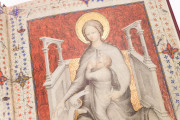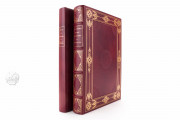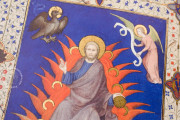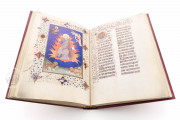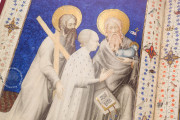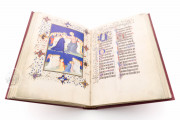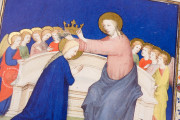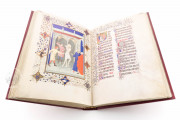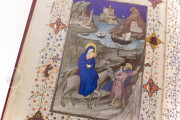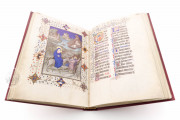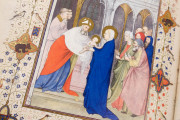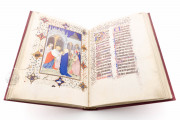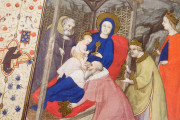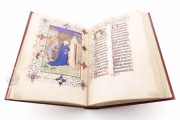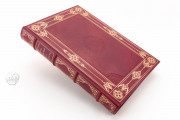The Brussels Hours—sometimes referred to as the Très Belles Heures but not to be confused with the manuscript in Paris, also nicknamed the Très Belles Heures—is a key monument of early fifteenth-century Parisian manuscript painting. Made in the first decade of the fifteenth century for the bibliophilic John of France (1340-1416), Duke of Berry, it is a book of hours, a type of Christian prayer book with a particular focus on prayers to the Virgin Mary. Its illumination comprises twenty full-page miniatures and seventeen historiated initials with border extensions.
The manuscript is remarkable for the stylistic eclecticism of its illumination, with its fusion of French and Italian stylistic features. The historiated initials are the work of an Italian painter active in Paris, called the Master of the Brussels Initials after his work in this book.
Portraits of a Duke
The Brussels Hours is renowned for its two portraits of Duke John. The first is found in a composition that spans an opening of two full-page miniatures. It shows John kneeling in prayer flanked by his patron saints, Andrew and John the Baptist, on the left page, and the enthroned Virgin nursing the infant Jesus, on the facing page (pp. 10-11). The painting technique is semi-grisaille, with the furniture and the figures' drapery in tones of gray and the backgrounds, human flesh, and attributes in color. These miniatures seem to have been created for another book.
The second portrait is a full-page miniature in jewel-like colors. It depicts the duke kneeling before the Virgin and Child, again accompanied by his patron saints (p. 14). The Christ Child raises his hand in a gesture of blessing toward the duke, and a trio of angel musicians performs at the foot of the Virgin's throne.
Miniatures: The Work of a Team
The artist of the opening pair of miniatures was responsible only for that two-page dedication scene. The remaining eighteen full-page miniatures are the work of a team of three or more artists, at least one of whom was conversant in current trends in Italian painting. There is ample evidence from the visible underdrawings that the illuminators altered details of the compositions from the original designs.
Prophets in the Initials
The Master of the Brussels Initials—who worked first in Italy, then in Paris, and then returned to Italy—was responsible for the historiated initials introducing new sections of text. Unusually, most of the subjects in the Hours of the Virgin are taken from the Old Testament and include prophets (pp. 19 and 55), Moses kneeling before the burning bush (p. 73), and the Queen of Sheba presenting a gift to King Solomon (p. 91). Also depicted is the legendary encounter between the Roman emperor Augustus and the Tibutine Sybyl (p. 83).
A Large, Handsome Book
Although not the largest of the Duke of Berry's many splendidly illuminated books of hours, the book's pages are large for a private prayer book, and the text is accordingly written in two columns. A single scribe wrote the text in a consistently elegant Gothic Textualis script. Some of the pen-flourished initials are manifestly the work of an Italian, perhaps an associate of the Master of the Brussels Initials.
Owned by Margaret of Bavaria
The manuscript incorporates an oil painting on leather of the legendary cloth of Veronica that received the impression of Christ's face (p. 8), a work probably dating from around 1400. It may have been added to the prayer book when it was in the possession of Margaret of Bavaria (1363-1423), Duchess of Burgundy. The manuscript is next documented in the 1830s as part of the library of the dukes of Burgundy, one of the foundation collections of the Bibliothèque royale de Belgique (also known after 1954 as the Bibliothèque royale Albert Ier), since 2019 the KBR.
We have 1 facsimile edition of the manuscript "Brussels Hours": Brüsseler Stundenbuch facsimile edition, published by Faksimile Verlag, 1996
Request Info / Price

